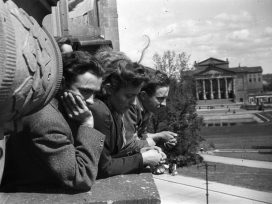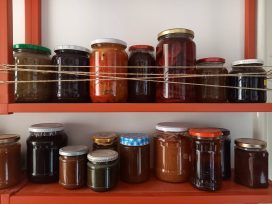Over the last decade, many voices have convincingly compared the condition of Polish serfs with the condition of slaves, in the context of Polish historical and sociological thinking as well as in public discourse. Texts were presented by Krytyka Polityczna, as a widely commented work in the field of historical sociology, in academic texts, in discussions in the public media and in private, even in internet forums. The trend has clearly intensified, especially among left-leaning authors. I have no doubt that thanks to these new interpretations of the past we will now be better able to work through some current issues. Having said that, I would like to add that the freedom of interpretation should also account for a variety of interpretations. Thus, this article is an attempt to compare different theses and anti-theses regarding the cultural economy of serfdom.
The field of cultural economy includes issues of identification, ideology, convictions, value systems or – speaking differently – institutions, practices, and texts that shape the cultural context of the functioning of the economy. This article is divided into sections that allow some of these topics to be highlighted.
Economy
In Samuel Orgelbrand’s Encyclopedia, the term ‘serfdom’ is explained as follows: “a duty of a peasant subject to perform an unpaid work on the landowner’s field, or in within his farm, which lasts a few days per week or for the whole week, when the landowner had a larger field and servants at his disposal. Serfdom took different forms in different parts of Poland. In some parts, it was a burden to the peasants who did not have free time to work on their own households; in others, especially on royal and church properties, it was required for only two or three days per week […] This kind of payment […] turned out to be very harmful for both the serfs and the landowners alike. Thus, it was for a reason why an old saying would call less worthy work ‘serfdom work’, as serfdom was indeed a waste of the work of the rural population.”
Serfdom became a “highly harmful payment” as a result of some local and continental factors. Already in the early 16th century, Poland was the most important European exporter of cereal grains. Its main recipient was Holland, and the money that came from this source is what allowed the Polish nobility to become rich since previously it did not have many opportunities to function on international markets. Thus, access to a large and highly absorbent market gave it an impulse to increase production. For this purpose large-scale farms were established, first near the large cities or on the banks of the Vistula River and its tributaries, which allowed for the transport of grains. An increase in export opportunities was then based on: 1) expanding export acreages; 2) development of large farms; and 3) the expansion of serfdom. In this way, the system of serfdom on large farms was cemented, becoming the Commonwealth’s economic basis, which lasted for almost three centuries.
The so-called secondary, or exacerbated bondage – Janusz Tazbir wrote about re-feudalization – which was based on peasants’ personal, land, and judicial dependence on the landowners was an important consequence of these processes. In the years 1518 and 1520 parliamentary decisions introduced the duty of serfdom of at least one day for the field of corn that was being used by the peasant, without marking the top boundary of this obligation. Since the end of the 15th century, more laws were passed to complete the bondage system between serfs and landowners. As a result, a landowner became both an owner and a judge of the peasants who lived on his land. Farms were governed by the cuius dominium, eius religio rule. Nobility had a monopoly in regards to land inheritance and power wielding. Also, higher state and clergy positions, as well as officer ranks, were only available to noblemen.
Extensive harvesting methods (including high intensity labor and its low costs) translated into low productivity. A visible difference was noted in regards to the type of work: serf or hired. Consider: when on royal farms in Prussia in the middle of the 16th century an annual crop yield would barely reach one and a half a thousand units; on farms that did not use serfs but hired workers, the number was higher than five thousand units.
Thus, the serf-based economy had many far-reaching consequences of social and cultural nature. It established “feeling structures” which allowed for an overall negative attitude to work. Speaking most generally, while the nobility got used to being lazy, peasants got used to pretending that they were working. Many authors were noting that in some regards, serfs were resembling the nobility – in their arrogance, willingness to have fun or by showing off. Based on the logic of the long-term existence of these structures Wincenty Witos wrote that “the worst landowner is a poor rural dweller.” Melchior Wańkowicz wrote about a rural boy whom he had helped get a driving license and was paying to be his driver. During one of their rides, when a peasant wagon got in their way, the boy shouted: “Get out of our way you hick!” Historian, Jan Borkowski, completed these remarks with a more general observation: “A freed peasant could do whatever he wanted with himself and his time, at least to some extent. It was not good food that he missed the most, not the creature comforts, which he did not know, not the culture, about which he had no idea, but the sweetness of inactivity. The peasants’ dream partially came true, they worked as little as possible to live a low-standard life; one they were used to since they were born.” This problem was skillfully summarized by a positivist and, the founder of agricultural schools, named Aleksander Świętochowski who wrote: “With a relatively few exceptions, independent Poland welcomed uneducated, socially unskilled, and morally handicapped peasants. This group got a large number of parliamentarian mandates and exploited them to steal, without any qualms, and fulfil their personal and class needs. However, when it came to the nation, they remained stingy and completely indifferent.”
Serfs were using a wide array of forms of resistance. The most often used was passive resistance, which included: “coming late to work, using worse and constantly breaking tools, […] slowness in performing work, […] organized refusal to do serf work.” A different form were written complaints. Escapes from villages, at times individually, but also in groups, were also quite common. Their scale was so large that special “corridors” were created, and a displacement of ethnic group borders took place. The paradox was that the landowners, who were condemning the escape of their own serfs, were happily welcoming fugitives from different farms, relieving them from serfdom.
Armed actions were the most radical forms of resistance. Initiated by the Hussite movement in the 15th century, they were later a reflection of the reformist activity; in addition there were the highlanders’ fights (starting with Mucha in 1492 to Kostka Napieralski in 1651). In the 18th century the serf “boiling” was taking place on the entire territory of the Commonwealth.
Society
The serfdom system developed within a characteristic social structure. Already at the turn of the 16th century, the nobility constituted 10% of the Commonwealth’s population. At the end of the 18th century the population composition was the following: Nobility – 9% (to compare in France it was 0.7%, while in England 3%), Bourgeois – 16%, Peasants – 75%, Clergy – 0.3%. Twenty-five percent of the nobility were ethnic Poles, over 75% of the bourgeois were Jews. The general conclusion of this data is the following: an ethnic Pole was either a peasant or a nobleman (rarely a city dweller). “In Poland two, near-nations appeared – nobles and peasants, and between them there was a Jewish wall.” Ethnic unity did not hence translate into a moral or social unity.
To distance itself from the peasants, the nobility (and clergy) cultivated a belief in their genetic superiority over the peasants. Consequently, the popular ethno-genetic myths presented Polish noblemen as descendants of the Sarmatians, while peasants were to come from the Dacians or the Gepids. In a Bible-based version of this conviction, the predecessor of the nobility was to Japheth, while the predecessor of the peasants was Noah’s son, Ham, who had been cursed by his father (actually also a farmer) and degraded, together with his descendants, to the level of slaves, “servi servorum.” Thus, Bartosz Paprocki, author of the 1584 Herby rycerstwa polskiego (Coats of Arms of Polish Chivalry), did not have any doubts that the pedigree of the nobility could have been dated to the most remote Biblical times. The coats of arms were granted “right after the flood,” hence both Noah and his descendants had them (with the exception of Ham). This origin of the chivalry was to be strengthened in the features that were transferred from one generation to another, and they were both psychological and mental. Nobility was something granted by birth, genetically and thanks to inherent spiritual and physical features. Thus, an 18th century doctor could have even been convinced that peasants “in their heads had bones in the shape of a plough and agricultural tools.”
An emergence of a social elite required a defined mass. Being seen as such a mass, peasants were assigned such seemingly natural features as: laziness, cunningness, suspiciousness, etc. Semantically, the term nobility inclines noblesse, while the term lord, lordliness. In turn, a peasant, also known on the territory of the Commonwealth as cham (the name is derived from Noah’s son – Ham) becomes a given and a common name. The basis for this transformation from a given name to a common name were, on the one hand, the Bible (Ham was degraded by the divine power to a servus), and on the other hand, the Roman law (servus as a subject of the will of law), functioning together as a source of Sarmatia’s self-knowledge. Eventually, the word “cham” used to describe serfs, became a collective, homogenizing “last name” for representatives of the whole social class.
The definition to a “cham” in the earlier quoted Orgelbrand’s encyclopedia is the following: “A cham is a scornful expression used to describe a peasant, a churl, somebody of an inferior background, recognized as descendants of Ham, Noah’s son. ‘You cham, plough the field, do it, be careful who is nobility, and who the chams are’ (A. Naruszewicz). During the times of Stanislav Augustus’ rule those who were pretending to be nobility, but did not have a coat of arms, were described as follows: ‘He is a good nobleman from a peasants’ voivodship, from the serfs’ land’.” Interestingly, the process of changing the Biblical name Ham into a common name (cham) used to describe serfs was limited solely to Slavs. It was possible thanks to the patriarchal social structure which was characteristic to Slavic ethos. Thus, the analyzed relations between the descendants of Japheth/Sarmatians and the descendants of Ham/Dacians or the Gepids, are better understood when looked at through class categories than “tier differences.”
The linguistic and mental differentiation between serfs and nobility had also a matrimonial dimension: “Nobility does not enter, or does so very unwillingly, into marriages with serfs, regarding them as a lower species. ‘A serf is always a serf!’ – claims a stubborn nobleman. Mixed marriages were seen like this: ‘When a nobleman marries a serf woman, the Virgin Mary is happy that the noble family is expanding, but when a noble girl marries a serf, the Virgin Mary cries with heavy tears as the noble blood will get spoiled by the peasant one’.” Thus, a marriage between a noble girl and a serf was treated as a “disgrace to the noble tier” which could bring on divine punishment. Such cases were condemned even by Wacław Potocki, who was known to have been a “defender of the peasants.” What is characteristic, sexual relations between a noble man and a peasant woman were perceived able to “improve the race.” This, however, was regardless of the fact that a “subject woman was almost defenseless in face of her lord.” Courts would examine rapes of peasant girls only when they were subjects of a different lord or a different landowner than her own. Financial compensation for harm was usually paid to the village’s owner.
Diversity
The Above theses only seemingly provide arguments to put on par the status of a serf with the status of a slave. Such an attempt could be questioned by data that shows diversity that was characteristic both of the peasant and the noble class structures.
First of all, the noble class was far from homogenous. By the end of the 18th century 1% of its population were magnates, 4% estate owners, 40% petty nobility and 55% landless nobility. Over half of the representatives of nobility was hard to distinguish from the peasants, which was a result of their low level of material and social capital. Secondly, differences could be also seen within the composition of the Commonwealth’s rural population. In this case, differences had legal, economic, and social standings. Thus, peasants cannot be treated as a homogenous group, without a risk of oversimplification and ideological judgements.
At the most basic level, the rural community should be seen as economically diverse. A few basic segments can be distinguished in its composition which included: owners of over 17 hectares, farm owners, who had a farm, a garden and a small field, landless peasants who did not own fields and were working for others, landless, farm-less peasants whose right to dwelling was a condition of their work. Finally, by the end of the 16th century the largest landowners were the largest group representing 53–39% (depending on the region) of the rural population. They were followed by farm owners, landless peasants and landless, farm-less peasants. Altogether these groups constituted 43–24%. The population was completed by artisans, tavern owners, millers, petty traders as well as nobility: estate owners and landless. The landless were often involved in different rural artisan services. In addition, the diversity of rural communities was related to village types. Overall, there were three types of villages: noble, royal and those belonging to the church. In royal and church villages, peasants could appeal to local administrator (starosta) or a different representative of authority. In royal villages (over 300 villages) there were no noble privileges increasing bondage. These localities were governed by characteristic self-governments, which comprised their inhabitants and were led by a local leader or administrator (wójt or starosta). Such organized local governance bodies, even though subject to the lord, had real power. Rent and fees were established by their representatives, while the internal judiciary included representatives of the rural community. Serfs were not paying taxes to the state, they did not serve in the army, and additionally did not know that they could count on their lord’s assistance in regards to, for example, tax relief or inventory assistance.
Within self-governing rural institutions, there were yet strong divisions between the rich and the poor. At least since the 16th century there were visible differences between “large field owners, estate owners and estate owners who owned cattle and those who did not, as well as different types of peasants, […] those who were richer would make those who were poorer more dependent on them by leasing land, crops or lending money at usurious rates or to be paid back with work.” Stefan Czarnowski saw the internal diversity of the rural population as a characteristic of royal, noble and church villages. In his view, within the peasant class, there were “bondage-like relations” between different segments, “even though they were not regulated by law.” Wealthier owners would establish “oligarchies of patrons” gathering around themselves smaller farmers and farm-less nobility. In such an arrangement, serfs could count on the fact that that they would receive certain assistance from their patrons (at the times of natural disaster or a death in the family), sometimes debt relief or representation before the courts.
Another factor that differentiated the serfs was a practice of large farms in Prusy Królewskie to rely on hired work and seasonal workers. This led to a situation where in this area land attachment never became materialized. As mentioned earlier, peasants were escaping on a large scale to unmanaged or empty areas or to the cities.
The Issue of Slavery
The term “slavery,” commonly used in academic and popular discourse, has a clear meaning which is not easy to explain; for its proper understanding we “need to completely eliminate concepts that we derive from reading about American plantations or ancient Rome.” In essence, slavery is a type of social relation that can be regarded as a dependence system. It inclines a situation where one person is “deprived of all elements of freedom and is completely subjected to the authority of the owner […] from the legal point of view a slave was first of all an object, and not a human being.” This is how slavery was perceived by Roman law which assumed that a slave was the subject of complete authority of another person, and the basis of this authority was property.
In many cases, slavery is mistakenly treated as a kind of service. In different languages words translated as “slave” are actually referring to a person that is dependent. In the Middle East and northern India, service was one of the basic ways to enter the privileged classes (military and administration). “Slaves” who started working with the traders were allowed trade profits, and could even count on becoming shareholders or co-owners. In some professions the border between a slave and a student and a journeyman almost disappeared. Among some African tribes and Jewish communities in Egypt, slaves were gradually turned into family members. Ancient Greek had many descriptions that were used in regards to slaves, but some of them were also used in regards to free household dwellers. In the polis, lower and middle-lever administrative roles were reserved for “state slaves.” In Ottoman Turkey, state workers were recruited from among Christian slaves. What is more, in the religious imagination of South Indian saint-poets, slavery was a metaphor for a search for God by the pious. Becoming a servant of a lord and becoming dependent on him was leading to perfect freedom. In all these cases terms such as “servant,” “solider,” “subject,” “client” should be used instead of the word “slave.” Jack Goody also postulated the need to differentiate between different “levels of slavery”: from full and unconditional dependence on a lord, to being a member of a household. An inter-cultural optic does not allow for automatization in this regard.
Also, the supporters of a processual perspective do not opt for expanding this concept. For them the key to a slave’s social identity is marginality and ambiguity of status. This means that slavery starts with being captured or sold into captivity and in consequence, from the moment of losing one’s social identity. A slave is hence a person who has been excluded from the primary social arrangement, and then turned into a good.
Anthropologists warn against too much ease with associating numerous hierarchical forms of social relations with slavery. This conviction also refers to social relations in serfdom. Slavery played an important role in the large estates of the Roman Empire. It gave space to medieval servitude. Finally, in the late Middle Ages slavery “played almost no role in European villages, as it was replaced by numerous forms of feudal dependencies.” Serfs were not slaves. They were not goods at slave markets nor were they deprived of primary identity. Serfs were subjects forced to work. They were clients of the landowner (lessors). Re-feudalization did not mean yhe establishment of slavery.
Thus, terminological subtleness is of key significance. First of all, it inclines awareness of historical context, which hinders moving certain concepts between epochs and cultural systems. Secondly, using the concept of slaves to “cover” serfdom can blur the internal diversity (legal, economic and social) of old villages; a diversity of the noble tier, as well as the agency of serfs, was based on the autonomy of self-governments and the rights they enjoyed. Thirdly, including a whole population of serfs in a group of slaves confirms the problem that comes (and not only for the anthropologies) with the term “peasants,” which emerged as a “new prototype other” and was constructed around the primitive/modern logic.
There has never been one, homogenous, subject to a uniform jurisprudence, peasants’ mass that is effectively attached to land. That is why, its subjective understanding requires a correction of such a persuasive image. Otherwise, we will hurt a social actor – the serf. One more time.






